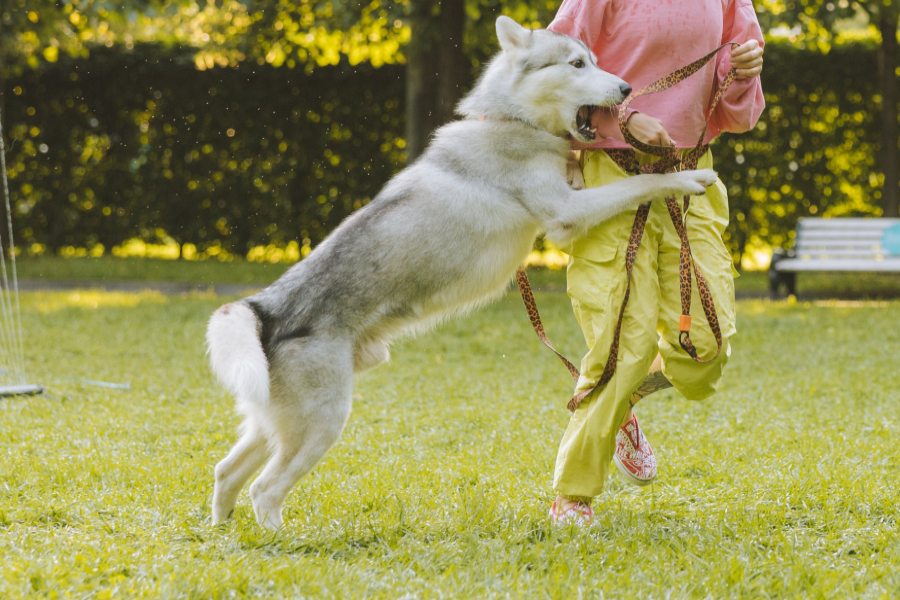Siberian Huskies, known for their striking appearance and vibrant energy, possess remarkable physical abilities, including an impressive jumping capacity. This article delves into the fascinating world of Huskies, explicitly exploring how high they can leap. Renowned for their strength, agility, and endurance, Huskies are more than just sled dogs; they are athletic creatures with a surprising aptitude for vertical challenges. From understanding their unique physical characteristics to examining the factors that influence their jumping prowess, we will uncover the secrets behind the Husky’s ability to soar and provide insights for Husky owners to manage and nurture this skill effectively.
How high can a husky jump?
Huskies are known for their athletic abilities, and they can jump quite impressively. On average, a healthy, well-exercised Husky can jump about 4 to 5 feet high. However, this can vary based on age, health, and training. Huskies have strong hind legs and a lean build, contributing to their jumping capabilities. It’s important to note that while Huskies can jump high, excessive jumping should be monitored to prevent potential joint or muscle injuries. Regular exercise and proper training can help maintain their jumping abilities in a safe and controlled manner.
Jumping Abilities Of Huskies
The jumping abilities of Siberian Huskies are remarkable and are influenced by several factors. Here’s an in-depth look at this aspect:
Physical Attributes: Huskies are medium-sized dogs with a muscular build, aiding their jumping ability. They typically weigh between 35 to 60 pounds, with a well-proportioned body that is neither too heavy nor too light for practical jumping.
Leg Strength and Structure: One of the critical factors in a Husky’s ability to jump is their strong hind legs. They have powerful muscles in their hindquarters, which provide the necessary force for high jumps.
Agility and Speed: Huskies are not just strong but also agile and fast. This combination of speed and strength allows them to take off with significant force, contributing to higher jumps.
Energy and Stamina: Huskies are known for their high energy levels and stamina, partly due to their origins as sled dogs. This endurance also affects their ability to jump repeatedly without quickly tiring.
Average Jumping Height: While individual abilities vary, a healthy and active Husky can typically jump about 4 to 5 feet high. Some may even surpass this height with proper training and conditioning.
Training and Conditioning: Training can significantly enhance a Husky’s natural jumping ability. Activities like agility training, hurdle jumping, and regular exercise can help a Husky reach its full jumping potential.
Individual Variation: It’s important to remember that each Husky is unique. Age, health, diet, and exercise influence a dog’s jumping capability.
Potential for Escape: Given their ability to jump high, Huskies can be skilled escape artists. Owners must ensure that fences and enclosures are sufficiently high to contain these adventurous dogs safely.
The Science Behind Jumping Of Huskies
The jumping ability of Huskies, like any other physical activity in dogs, is a complex interplay of anatomy, physiology, and biomechanics. Let’s break down the science behind how Huskies jump:
Huskies have a well-developed musculoskeletal system that is essential for jumping. Their muscles, especially in the hind limbs, provide the power needed for lift-off. The skeletal structure, particularly the spine, pelvis, and hind legs offers the necessary support and leverage.
Huskies possess a high proportion of fast-twitch muscle fibers in their hind legs. These fibers are designed for quick, explosive actions like jumping. They contract faster than slow-twitch fibers, providing the sudden burst of power needed for a high jump.
The joints in a Husky’s legs play a critical role in jumping. The hip, knee, and ankle joints work harmoniously to extend forcefully, propelling the dog into the air. Good joint health is crucial for maintaining jumping ability.
The tendons in a Husky’s legs act like springs, storing energy when the muscle contracts and releasing it during the jump. This elastic energy contributes significantly to the height achieved during a jump.
Jumping is not just about raw power; it requires coordination. The nervous system plays a vital role in timing the muscle contractions and ensuring the body is aligned correctly for an effective jump.
Mid-air body control is crucial for a successful jump, especially when navigating obstacles. Huskies have a keen sense of balance and body awareness, which helps them adjust their posture and trajectory during a jump.
Regular and specific jump training can enhance a Husky’s natural abilities. Training helps improve muscle strength, joint flexibility, and neuromuscular coordination, all vital for maximizing jumping potential.
A balanced diet is essential for maintaining the overall health and energy levels of Huskies. Proper nutrition supports muscle growth and repair, joint health, and energy metabolism, all contributing to their jumping ability.
How To Train Huskies To Jump?
Training a Husky to jump involves a combination of physical conditioning, obedience training, and positive reinforcement. Here’s a step-by-step guide to train Huskies to jump effectively and safely:
- Health Check and Assessment: Before starting any training program, ensure your Husky is healthy. A veterinary check-up can confirm that your Husky is fit for jumping activities.
- Basic Obedience Training: Ensure your Husky has a solid foundation in basic obedience commands like ‘sit,’ ‘stay,’ ‘come,’ and ‘heel.’ This obedience is crucial for controlling and directing them during jump training.
- Introduce Jumping Gradually: Start with low obstacles, like a trim stick or a low bar, to get your Husky used to jumping over things. Encourage them to walk over it first, then gently coax them to hop over.
- Use Positive Reinforcement: Reward your Husky with treats, praise, or playtime whenever they complete a jump. Positive reinforcement encourages them to repeat the behavior.
- Increase Difficulty Slowly: As your Husky becomes more comfortable and skilled at jumping, gradually increase the height of the obstacles. Ensure the increments are small to avoid putting too much strain on their joints.
- Focus on Technique: Pay attention to your Husky’s jumping technique. They should use their hind legs to push off and land smoothly on all fours. If they struggle, reduce the height and work on technique before progressing.
- Incorporate Agility Training: Agility courses with various obstacles can be an excellent way to improve your Husky’s jumping skills. It also helps in enhancing their overall agility, coordination, and obedience.
- Regular Exercise: Ensure your Husky gets regular exercise to maintain their overall fitness, as this directly impacts their ability to jump. Running, playing fetch, or swimming are excellent for building muscle strength and endurance.
- Avoid Overtraining: Monitor your Husky for signs of fatigue or disinterest. Huskies are enthusiastic but can get tired or bored. Ensure training sessions are short and engaging.
Tips For Maintaining Joint And Muscle Health
Maintaining joint and muscle health in dogs, especially active breeds like Huskies, is crucial for their overall well-being and to ensure they can enjoy physical activities without discomfort or injury. Here are some tips for maintaining your Husky’s joint and muscle health:
Balanced Diet:
Ensure your Husky has a well-balanced diet appropriate for their age, size, and activity level. Look for dog foods rich in omega-3 fatty acids with a suitable protein, carbohydrate, and fat balance.
Weight Management:
Keeping your Husky at a healthy weight is essential. Excess weight stresses joints and can lead to joint problems and other health issues.
Regular Exercise:
Regular, moderate exercise is vital for maintaining muscle tone and joint flexibility. Walking, swimming, and gentle play can help without putting too much strain on the joints.
Warm-Up and Cool-Down:
Like humans, dogs benefit from a warm-up before intense activity and a cool-down period afterward. Start with a gentle walk or light play before moving into more vigorous exercise.
Joint Supplements:
Supplements containing glucosamine and chondroitin can benefit joint health. These supplements can help maintain cartilage health and joint fluidity. Always consult your vet before adding supplements to your dog’s diet.
Adequate Rest:
Ensure your Husky has a comfortable and supportive place to rest and sleep. A good quality dog bed can provide necessary support for joints and muscles.
Avoid Overexertion:
Be mindful of your Husky’s limits. Avoid overexertion, especially in extreme weather conditions, as it can lead to joint and muscle strain.
Regular Vet Check-ups:
Regular veterinary check-ups can help catch any early signs of joint or muscle problems. Your vet can also provide specific advice tailored to your Husky’s needs.
Massage and Physical Therapy:
Massage can help maintain muscle health and relieve tension. Physical therapy can be an excellent way to maintain mobility and comfort for dogs with existing joint issues.
Avoid Slippery Surfaces:
Provide non-slip surfaces where possible in your home, especially if your Husky is elderly or has joint problems. Slips and falls can exacerbate joint issues.
Warping Up
It’s essential to remember that Huskies are remarkable and energetic dogs known for their agility and jumping abilities. To train them effectively to jump, start gradually, use positive reinforcement, and focus on technique. Ensure they maintain joint and muscle health through proper nutrition, regular exercise, and weight management. Always monitor your Husky’s well-being and consult a vet for specific advice. With the right training and care, your Husky can enjoy a healthy and active lifestyle while showcasing impressive jumping skills.
FAQ’s
Q. Can dogs jump a 6-foot fence?
Many dogs, including some larger breeds, can jump a 6-foot fence. However, the ability to do so varies among individual dogs. Breeds with strong jumping instincts or athletic abilities, like Border Collies or Huskies, are more likely to clear a 6-foot fence. Proper training and secure fencing are essential to prevent escapes.
Q. What is the maximum height of a Husky?
A. The maximum height of a Siberian Husky typically ranges from 20 to 24 inches (51 to 61 centimeters) at the shoulder, with males tending to be slightly taller than females. However, individual variations can occur.
Q. Why does my Husky keep jumping the fence?
A. Huskies are known for their athleticism and love of exploration. If your Husky is jumping the fence, it’s likely due to their instinct to roam and explore. They may try to chase something, escape confinement, or simply exercise agility. To prevent this behavior, ensure your fence is tall and secure, provide ample exercise and mental stimulation, and consider professional training if needed.







Leave a Reply